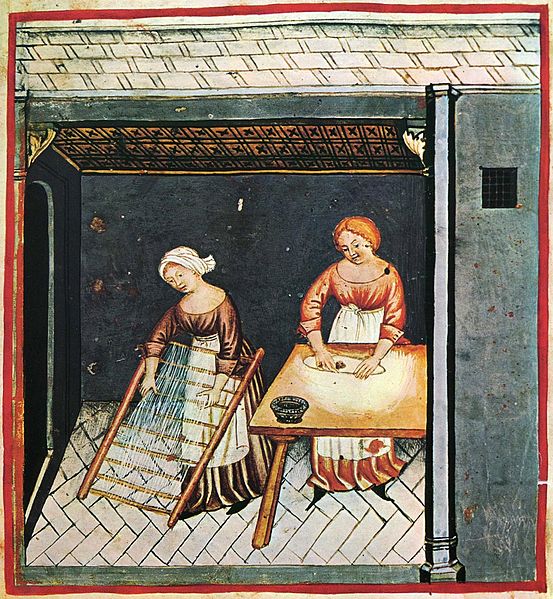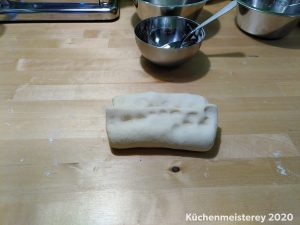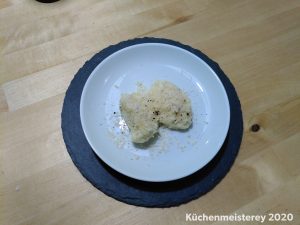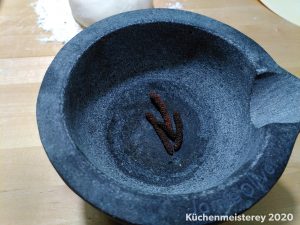
I was about to give up my hobby when I camped with the Communitas Monacensis in a medival fair across three cooks who stood and cooked all day in their camp kitchen. But above all, they were the first ones I met who cooked historical recipes. In this way they awakened my interest in historical cuisine.
A few years later, I was sitting with Janina for a chat. When I was able to answer her question about a historical recipe for mushrooms, we had found our common theme – the historical kitchen. As a result, our joint project “Blog von guter Speise” was born, where Janina guided me to interpret historical recipes in an orderly and clean way.
Today I still cook with many other cooks at medival fairs or at museum events. But I am especially happy that in the meantime Astrid has also started to cook according to historical recipes. And so today we are together in the kitchen and Astrid makes sure that I am not too sparing with salt and spices, so that in the end it doesn’t taste bland.
In the meantime I had the opportunity to organize a museum event about historical cooking at the Bachritterburg. After the first successful, but still a little bit chaotic, event Leah decided that I could more than use a helping hand for the following events. After one Küchenmeisterey and two cookbooks, the virtual Küchenmeisterey is now another event where she has taken over the organisation completely.
Janina, Leah and Astrid. ..thank you very much for everything
Lasagne Based ‘Liber de Coquina’ (beginning of 14t century)
An almost successful attempt at an interpretation
The Liber de Coquina was written down or copied by an Italian author shortly after 1300 and has been preserved in two codices together with some medical and agricultural writings. Today they are kept in the Bibliothèque Nationale in Paris.
Originaltext:
De lasanis : ad lasanas, accipe pastam fermentatam et fac tortellum
ita tenuem sicut poteris. Deinde, diuide eum per partes quadratas
ad quantitatem trium digitorum. Postea, habeas aquam bullientem salsatam,
et pone ibi ad coquendum predictas lasanas. Et quando erunt fortiter
decocte, accipe caseum grattatum.Et si uolueris, potes simul ponere bonas species puluerizatas, et pulueriza
cum istis super cissorium. Postea, fac desuper unum lectum de lasanis et
iterum pulueriza; et desuper, alium lectum, et pulueriza : et sic fac usque
cissorium uel scutella sit plena. Postea, comede cum uno punctorio ligneo
accipiendo.
(Unfortunately I have not found a free translation of this, but since I am dependant on a translation myself, I use the publication of Rober Maier: Liber de Coquina, Frankfurt 2005. In Maier’s case the recipe has the number xxx, since the recipes of both parts (Tractatus and Liber de Coquina) are counted consectuively in the edition).
Summary of the recipe in English:
From risen dough, make thin sheets of dough, cut them into rectangles, cook them and layer them alternately with cheese and spices in a bowl. Eat them with a wooden skewer.
The noodle in the middle ages:

Several historical cookbooks from the Middle Ages contain recipes for pasta dishes, including the Forme of Cury (England, late 14th century), the Liber de arte coquinaria by Maestro Martino (Italy, mid-15th century) and the Liber de Coquina (Italy, early 14th century).
Recipes for lasagne are described in the Forme of Cury and the Liber de Coquina (LC). The special thing about the LC recipe is that the dish is prepared with a risen dough (fermentatam).
ingredients:
- Flour (Tipo OO or type 405)
- Wheat sourdough
- Parmesan
- Other Italian cheese to taste
- Spices
Preparations:
The cooking/baking with Lievito Madre/wheat sourdough must always be prepared. I have chosen to refresh my sourdoughs when I prepare them. I have to do this early enough before the actual cooking:
this is how i cooked it (indluding the problematic quantities)
For the virtual Küchenmeisterey I only cooked a small amount, i.e. a tasting portion. For the pasta dough I used 250 g flour and 50 g Lievito Madre – plus water by feel. And this is where I suspect the problem of my interpretation lies. I borrowed the ratio of flour and sourdough from modern recipes for simple Italian bread and pizza dough. The result shows, however, that the proportion of sourdough was apparently too high for the pasta dough, as the consistency of the pasta was very slippery at the end. At the next try, I will reduce the proportion of the sourdough.
The individual steps:
- Knead the flour with the water until an even dough is obtained
- Let the dough rest for about an hour
- Flatten the dough and spread the Lievito Madre on top
- Fold the dough several times and let it rest for a short time
- Knead the dough until an even dough is obtained
- Place the dough in the fridge for cold fermentation for about 12 hours
- Take the dough out of the fridge and knead
- For a small table roll out in portions
- Cut the lasagne sheets to size
- Cook the leaves in boiling salted water al Dente
(In my case the noodle leaves simply skipped this state – see above) - Arrange the pasta leaves in layers with cheese and spices in a bowl or plate
- Serve
conclusion
I had wanted to try out the recipe for lasagne for a long time, and since I have been cultivating a Lievito Madre for a few weeks now, it was obvious to try it out in the virtual kitchen mastery. The taste of the lasagne could have been convincing, especially because the parmesan and pepper have made the sourdough taste very much less prominent. The mouthfeel alone left a lot to be desired (reminiscent of many a dish from the Chinese DimSung kitchen, although it is desired there). In any case, the recipe is worth trying out again and again until it meets my expectations.


































